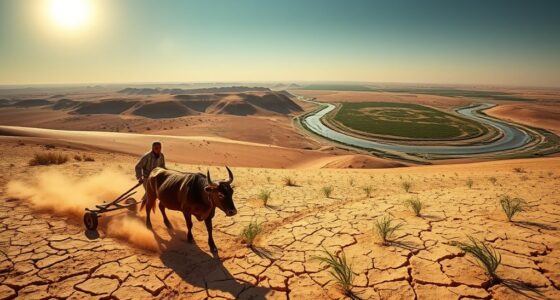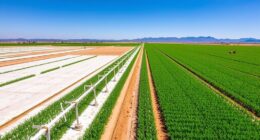Rewilding farmland is a fantastic way to restore ecosystems and boost biodiversity. To start, you can reduce livestock and halt low-yield farming practices, allowing natural regeneration to thrive. Introducing native species and creating wildlife corridors can enhance habitat diversity. Using methods like rotational grazing will improve soil health, leading to healthier ecosystems. Not only does this initiative fight climate change by sequestering carbon, but it can also open up new economic opportunities in eco-tourism and sustainable markets. If you're curious about specific strategies and community involvement, there's plenty more to explore on this important topic.
Key Takeaways
- Remove livestock and halt low-yield farming to promote natural regeneration and improve soil health and biodiversity.
- Implement rotational grazing and introduce keystone species to enhance soil health and ecosystem resilience.
- Create wildlife corridors by connecting wild patches, supporting species movement and ecological balance.
- Engage local communities in rewilding initiatives to foster stewardship and sustainable practices.
- Conduct baseline surveys to monitor biodiversity and carbon capture, adapting strategies based on progress.
Understanding Rewilding Principles

Rewilding principles offer an invigorating approach to restoring ecosystems and tackling biodiversity crises while also creating economic opportunities for local communities.
By emphasizing active management, you can help restore ecosystems effectively. This involves temporarily removing livestock and halting low-yield arable production, allowing natural regeneration to flourish. You'll enhance soil health and biodiversity, which are essential in addressing the biodiversity crisis.
Shifting to medium productivity regenerative agriculture can further improve the land by converting low-yield fields into pasture, utilizing herbal ley mixes, and implementing rotational grazing.
Additionally, reintroducing locally extinct species and planting native flora will enrich habitat complexity and resilience.
Successful ecosystem restoration hinges on long-term planning and collaboration with local communities, fostering understanding and participation in these crucial efforts.
Benefits of Rewilding Farmland
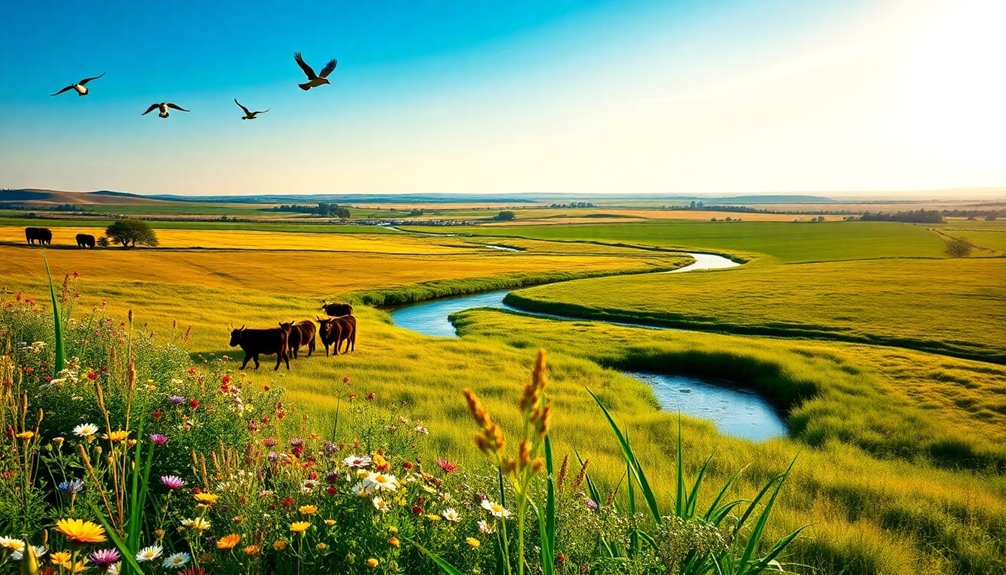
Transforming abandoned farmland through rewilding can yield remarkable benefits for both ecosystems and local communities.
By restoring just 15% of farmland, you could help prevent up to 60% of expected species extinctions globally. Increase that to 30%, and the potential rises to over 70%.
Rewilding farmland enhances biodiversity by reintroducing native species, creating habitats that support diverse life forms and stabilize food webs.
Additionally, these practices considerably contribute to carbon sequestration, with the ability to absorb an estimated 299 gigatonnes of CO2, aiding in climate change mitigation.
Improved soil health, better water quality, and enhanced ecosystem services like flood regulation further benefit both wildlife and human communities, making rewilding an essential strategy for a sustainable future.
Strategies for Effective Rewilding
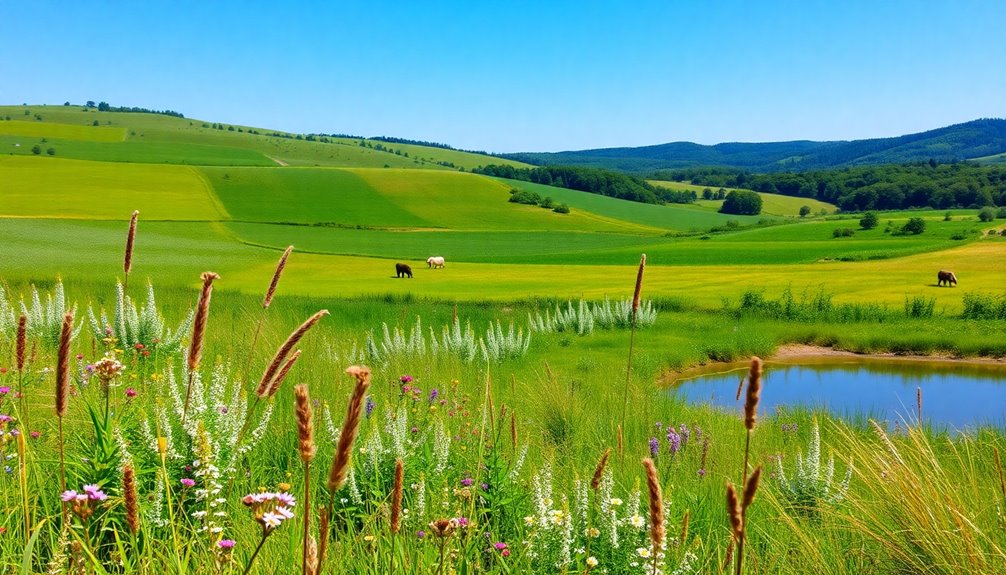
To effectively rewild farmland, you'll often need to implement a variety of strategies that promote natural regeneration and biodiversity.
Start by temporarily removing livestock and ceasing low-yield arable production, allowing ecosystems to thrive through the establishment of trees, scrub, and wildflowers.
Integrate rotational grazing with mob grazing systems to enhance soil organic carbon and diversify pastureland, benefiting both the environment and livestock.
Introduce keystone species like pigs at low densities to promote soil health and combat biodiversity loss.
Creating wildlife corridors by connecting wild patches and collaborating with neighboring landowners enhances ecological resilience.
Finally, establish a baseline survey for biodiversity and carbon tracking to monitor the impact of your rewilding projects and guarantee ongoing ecological progress.
Economic Aspects of Rewilding

When considering rewilding, you'll find that several funding opportunities can make this shift easier for farmers.
Not only can rewilding create jobs through new eco-tourism ventures, but it also opens up economic benefits that can boost your income.
As you embrace these changes, you might discover a sustainable future for both your land and your community.
Funding Opportunities Available
Numerous funding opportunities are available for those interested in rewilding farmland, making it easier to get started on these impactful initiatives.
Here's a quick overview of options you can explore:
- Woodland Carbon Guarantee: Supports carbon storage through tree planting.
- Environmental Land Management Scheme: Offers financial backing for regenerative agriculture and sustainable practices.
- Grants under Countryside Stewardship: Assist in financing biodiversity-focused projects and rewilding activities.
- Carbon Offset Markets: Provide potential future revenue by monetizing the carbon sequestration of restored lands.
These funding opportunities not only promote biodiversity and carbon capture but also enable you to contribute positively to the environment while generating income from your rewilding efforts.
Job Creation Potential
Rewilding farmland opens up exciting job opportunities, especially in eco-tourism and sustainable hunting, which can greatly boost local economies.
As you embrace rewilding, you'll find that sustainable land management practices require fewer interventions, easing financial burdens on farmers while improving ecosystem services. This shift not only creates jobs but also promotes environmental stewardship among the community.
Financial support from organizations like the Independent Research Fund Denmark and the Carlsberg Foundation further enhances these initiatives, emphasizing the economic benefits tied to rewilding.
Additionally, leveraging carbon offset markets presents future revenue opportunities for landowners, encouraging sustainable practices.
With increased biodiversity, healthier ecosystems can lead to new markets, benefitting local farmers and solidifying the job creation potential inherent in rewilding efforts. Furthermore, understanding the importance of long-term financial planning can help farmers navigate the economic shifts associated with rewilding initiatives.
Economic Benefits for Farmers
As the job creation potential of rewilding becomes clear, farmers can also reap significant economic benefits from these initiatives.
Here's how rewilding can enhance your farm's profitability and sustainability:
- Improved Land Productivity: Rewilding can reverse soil compaction and erosion, boosting ecosystem services that enhance productivity and water quality.
- Diversified Income Streams: Utilize economically unviable land for eco-tourism and sustainable hunting, generating new revenue sources.
- Cost Savings: Implement sustainable practices like rotational grazing to cut costs and improve soil health.
- Funding Opportunities: Access various grants and carbon offset markets, providing financial support for adopting rewilding practices.
Policy and Implementation Challenges

Maneuvering the policy landscape for rewilding initiatives presents significant challenges, especially within the framework of the EU Common Agricultural Policy. This policy complicates the implementation of agri-environmental climate schemes, hindering biodiversity efforts across Europe.
In contrast, post-Brexit UK subsidy schemes are creating more favorable conditions for rewilding, opening doors for land restoration. However, historical land use and ownership patterns still play a significant role, requiring tailored approaches to each region's unique context.
Collaboration among scientists, policymakers, and local communities is essential to align restoration goals with local needs. Additionally, securing financial support from governmental bodies and carbon offset markets is important to overcome initial implementation costs and guarantee the success of rewilding projects.
Enhancing Biodiversity Through Rewilding
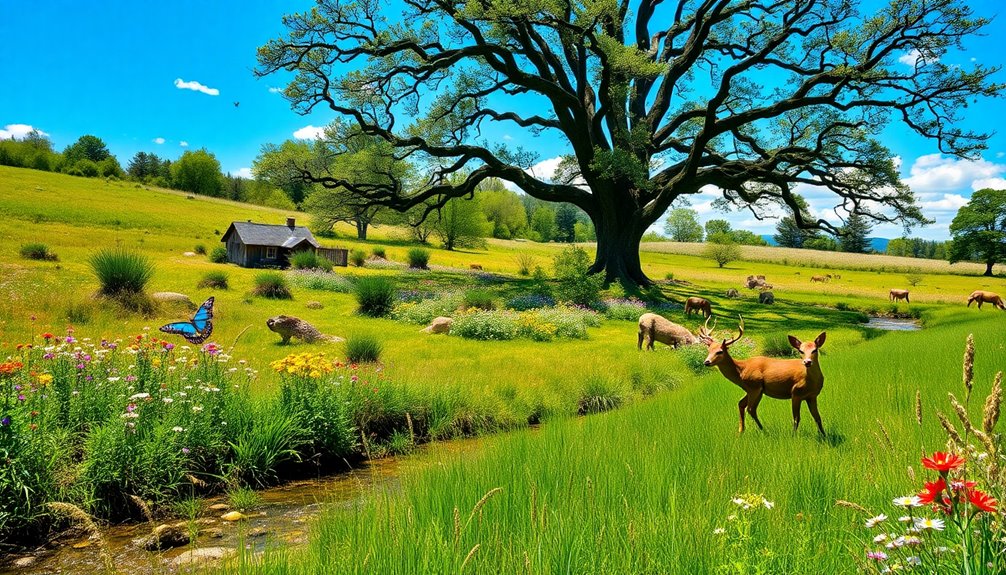
The practice of rewilding abandoned farmland serves as a powerful tool for enhancing biodiversity and restoring ecological balance.
Through strategic efforts, you can contribute to a thriving ecosystem.
Here's how rewilding boosts biodiversity:
- Restoration of 15% of global farmland helps prevent 60% of expected species extinctions.
- Reintroduction of large herbivores creates diverse vegetation mosaics, supporting various plant and animal species.
- Native species, like apex predators, restore ecological balance and foster greater biodiversity.
- Wildlife corridors enhance habitat connectivity, improving survival prospects for threatened wildlife.
Practical Steps for Farmers
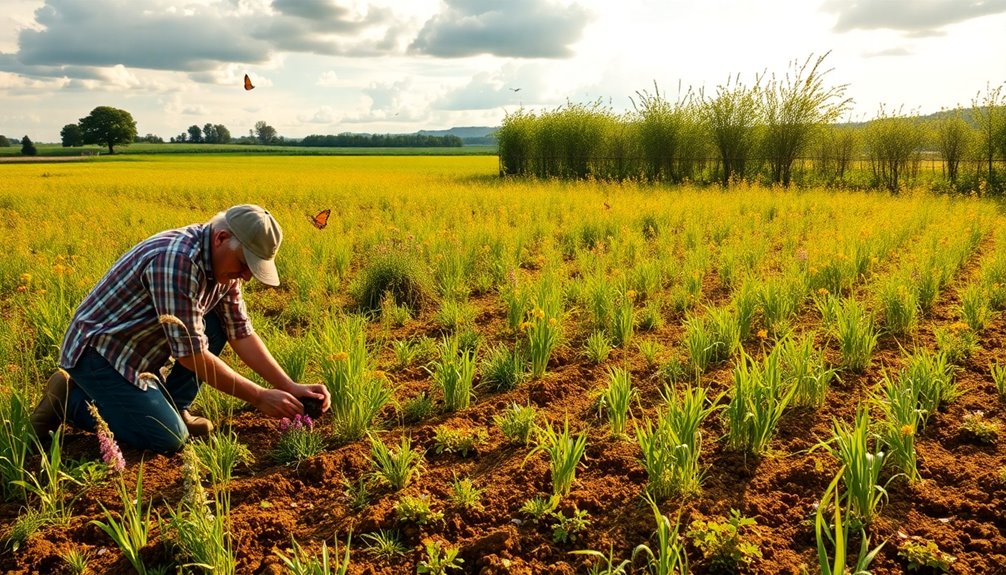
Implementing rewilding practices on your farmland can greatly enhance biodiversity and restore ecological health.
Start by conducting a baseline survey to assess current biodiversity and carbon credits. Temporarily remove livestock and cease low-yield arable production to allow for natural regeneration, fostering diverse vegetation, including trees and wildflowers.
Next, implement rotational grazing with a mob grazing system to improve soil health and ecosystem diversity. After 5-10 years, introduce native herbivores for conservation grazing, which will enhance habitat heterogeneity.
Finally, collaborate with neighboring landowners to create wildlife corridors, connecting fragmented habitats and promoting species movement.
These practical steps not only combat habitat loss but also cultivate a thriving ecosystem that benefits both nature and your farming practices.
Future of Rewilding Initiatives

As you consider the future of rewilding initiatives, it's essential to think about sustainable funding strategies that can support long-term projects.
Engaging local communities is just as important, as their involvement can drive successful outcomes and foster a sense of stewardship.
Together, these elements can guarantee that rewilding efforts thrive and benefit both nature and people.
Long-term Funding Strategies
Successful rewilding initiatives rely heavily on innovative long-term funding strategies that assure sustainability and community involvement.
To confirm these projects thrive, consider these approaches:
- Long-term financial schemes like carbon offset markets, allowing landowners to profit from ecological restoration.
- Government programs, such as the Environmental Land Management scheme, which supports regenerative agriculture and rewilding practices.
- Biodiversity Net Gain legislation, incentivizing projects that enhance local ecosystems.
- Securing funding from organizations like the Independent Research Fund Denmark and the Carlsberg Foundation to bolster research and support efforts.
Exploring available grants for biodiversity and carbon capture will help you secure essential resources for ongoing rewilding endeavors, emphasizing the critical role of financial support in successful restoration programs.
Community Engagement Importance
Community involvement plays a pivotal role in the success of rewilding initiatives, shaping both the outcomes for biodiversity and the connection residents feel to their environment.
When you engage with your community in these projects, you not only help restore ecosystems but also raise awareness about critical ecological issues. With 69% of global wildlife populations having declined since 1970, your participation is essential for fostering a sense of stewardship.
Collaborating with local stakeholders, like farmers and conservationists, optimizes resource sharing and enhances restoration efforts. Programs like #GenerationRestoration highlight the importance of community-driven initiatives, empowering you to monitor and maintain rewilded areas. By embracing mindfulness and presence, community members can deepen their commitment to the rewilding process.
This engagement strengthens the long-term resilience and health of restored ecosystems, benefiting both nature and your community.
Frequently Asked Questions
How Does Rewilding Increase Biodiversity?
Rewilding increases biodiversity by restoring natural habitats and encouraging diverse plant and animal species to thrive.
When you reintroduce large herbivores, you create varied landscapes that support different flora and fauna. This enhanced habitat heterogeneity promotes interactions among species, allowing for natural plant dispersal and the establishment of rich communities.
Plus, by fostering natural disturbances, you help recover wildlife populations and strengthen ecosystem resilience, leading to a healthier, more stable environment.
How to Improve Biodiversity in Agriculture?
To improve biodiversity in agriculture, you can start by implementing crop rotations and integrating diverse crops with livestock.
Reducing tillage and using natural fertilizers enhances soil health, supporting a variety of organisms.
Establishing hedgerows and wildflower strips will attract pollinators and beneficial species.
Engaging in regenerative practices, like conservation grazing, maintains habitat diversity.
Finally, adopting agroecological principles prioritizes sustainability and ecological interactions, ultimately restoring balance within your agricultural landscape.
What Are the Ways of Restoring Biodiversity?
Isn't it incredible how small changes can lead to big transformations?
To restore biodiversity, start by reducing chemical use and allowing natural regeneration on your land. Introduce keystone species to help balance ecosystems and create wildlife corridors to connect habitats.
You can also adopt low-intensity farming practices, fostering a resilient environment.
Why Is Rewilding Controversial?
Rewilding's controversial because it raises concerns about land use, as farmers worry about losing productive farmland.
You might see critics arguing that it can disrupt existing agricultural systems and livelihoods.
The potential reintroduction of large herbivores and apex predators adds ethical dilemmas, impacting both wildlife and safety.
Additionally, skepticism about rewilding's effectiveness in restoring biodiversity often leads to debates over funding and resources, dividing stakeholders in the process.
Conclusion
Incorporating rewilding practices on farmland can transform landscapes and boost biodiversity. Did you know that rewilding can increase species diversity by up to 50% in just a few years? By embracing this approach, you not only restore ecosystems but also enhance the resilience of your land. As you take practical steps towards rewilding, you're contributing to a healthier planet. Together, let's create thriving habitats that benefit both nature and farming for generations to come.




